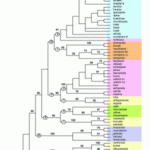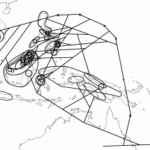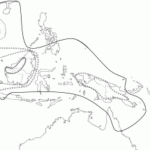- The geographical distribution of 67 taxa of Nepenthes in South-east Asia which show no incongruence in gene topologies.
- Four taxa, out of a total of 14 taxa, which show incongruence in gene-tree topologies, and may therefore be of hybrid origin.
Project Description
In this study molecular data sets from the chloroplast (trnL – trnF) and nuclear genome (5S-NTS) were analysed to investigate phylogenetic relationships within the family. A third data set consisting of discrete morphological characters was also analysed and combined with the molecular data sets to generate a total evidence cladogram (right).
The two gene trees indicated incongruence of a number of taxa (15 taxa). Excepting these conflicting taxa, the overall tree topologies are largely congruent. The analysis included two artificial hybrids which occupied well-supported positions near their shared maternal parent in the trnL-trnF tree and near their paternal parents in the 5S-NTS tree. This suggested that maternal inheritance was a significnat factor, and implies that those taxa with conflicting topologies are of hybrid origin.
Twenty-one specimens with strongly conflicting topologies between gene trees were identified for exclusion from the combined analysis. A number of these species showed a similar pattern of incongruence, suggestive of two hybridogenic clades. One of these clades comprises some of the most common and widespread species in the genus, including N. ampullaria, N. mirabilis, N. rafflesiana, and N. gracilis.
The analysis suggests a circum-Indian Ocean origin for the genus with a highly conserved and relictual basal clade, and a recent and rapid expansion from New Guinea westwards into South-East Asia. A sequence of repeated vicariant events across the dry-climate corridor between the Philippines, Sulawesi and New Guinea appears to have been the most significant influence upon the evolution of Nepenthes. At least six independent clades have crossed this line from New Guinea in the east to the Sunda shelf in the west. Three lineages demonstrate similar vicariant events between Borneo and the Philippines.
There is no evidence for long-distant dispersal in the genus, and species that do not show hybridogenic origin are confined to single islands or island groups, whilst taxa of hybrid origin are sometimes remarkably widespread.
Josef Mullins (Reading University), Matthew Jebb (National Botanic Gardens).



